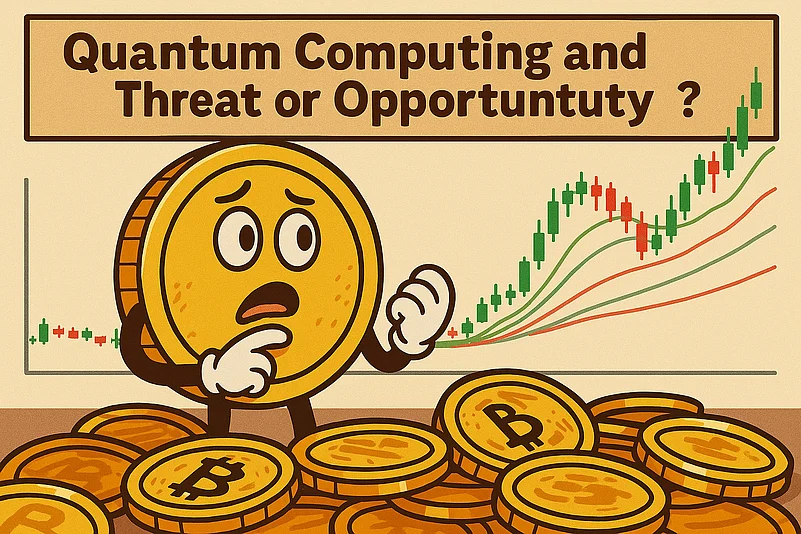The Race Between Two Revolutions
The two most disruptive technological revolutions of the 21st century are on a collision course. Quantum computing, on one side, is breaking barriers in processing power and promises to solve complex problems with currently unsolvable solutions. On the other side, digital currency—putting cryptography at work—has changed the world with new concepts of financial systems, decentralization, and trust.
In this crossroad of change, one important question arises: Will the advent of quantum computers destroy the cryptographic underpinnings of blockchain, or will the industry flourish and adapt in this new era of computation?
Comprehending Quantum Leap
Quantum computing is not just an improvement; it is a complete change as far as the functioning of computers is concerned. Quantum computers have qubits, capable of staying in multiple states at the same time because of the law of quantum superposition, as opposed to the bits of any conventional computer that have either a value of 0 or 1. Since these smaller machines can process data in parallel, different types of tasks can be carried out relatively faster by a quantum machine compared to that by the classical machines, which do not do these operations simultaneously but rather do them sequentially.
Quantum computing is bound to be a great revolution in the field of cryptography. Most currently used mechanisms of encryption for securing digital systems construct their schemes upon mathematical problems that are hard for classical computers to solve, while quantum computers are theorized to solve them much less easily. Tension arises as its equivalent role.
The Cryptographic Backbone Currently at Risk
The cryptography fills the hollow core or heart at the center of digital currencies; it controls everything from wallets to transactions to provide a trust-less, tamper-proof, and decentralized system. These cryptographic methods, especially those dependent on factoring large numbers or solving discrete logarithm problems, would still be vulnerable in a quantum age.
It is assumed that a sufficiently powerful quantum computer could reverse-engineer private keys from public information, nullifying any security currently extended by such a system. This could jeopardize personal accounts, as well as entire networks. Such a vulnerability is the last thing in the world for a technology that places an awful lot of faith in trustless systems.
Here or faraway: Does the threat exist?
The initial panic followed by a phase of complacency is the behavior regarding the threat posed by quantum computing to digital currencies. Theoretical breakthroughs indicate how possible it is for a quantum attack to be executed against the current encryption methods; however, such types of quantum computers capable of executing such attacks have not yet become practically realized in reality to date.
One of the most significant engineering challenges of our age is to create and maintain an error-free qubit at scale. Even the most optimistic of estimates suggest that we are still years-and quite possibly even decades-away from a machine that could crack real-world encryption in real time. The time frame allows the ecosystem of digital currency a significant window during which to prepare and evolve.
Adaptation and Evolution: The Post-Quantum Shift
The impending quantum threat is gradually being absorbed by developers, cryptographers, and researchers. A growing body within the technology ecosystem is working towards post-quantum cryptography-a new class of algorithms which aims to resist quantum attacks. These quantum-resistant protocols intend to future-proof systems by means of constructing encryption algorithms that stand very little chance of being broken even by quantum machines.
Blockchain networks may be upgraded almost infinitely through consensus mechanisms. Therefore, if heavily coordinated and with clear foresight, the ecosystem could migrate to post-quantum cryptography before large-scale constraints in quantum materials. That said, some experimental protocols have already begun testing such algorithms, laying the foundation for establishing a quantum-resistant structure under full security.
Quantum as an Ally, Not Just a Threat
Wherever threat angles are discussed, there is a need to integrate the opportunity aspect of quantum computing in the discussions. Supercharged by quantum technologies, applications including blockchain may find breakthroughs in optimization, simulation, and data analysis.
Picture decentralized platforms that process extremely demanding smart contracts and simulate entire economic models at quantum speed and efficiency. Quantum-enhanced consensus mechanisms could facilitate scalability and energy efficiency in a way that addresses several key limitations of current systems.
Also quantum generation of random numbers can bring in results with true unpredictability making yet another layer of security and fairness in decentralized applications with randomness dependent on it.
Building Bridges Between Two Frontiers
Collaboration and cooperation are the way forward for both these domains rather than confrontation. Quantum computing and blockchain are two advanced subjects and avant-garde arts that challenge convention. They may create an environment in which both technologies can co-evolve through encouragement for cross-disciplinary research by governments, academics, or industry leaders.
Some initiatives of major importance are the standardization of quantum-safe encryption, education of developers on quantum risks, and funding of innovation on quantum-resistant blockchain infrastructure. Such efforts will ensure that society protects the integrity of decentralized systems while maximizing quantum computing potential.
Conclusion: The Inevitability of Intersecting Approaches
The intersection of quantum computing and crypto is not a hypothetical future-it is a terribly approaching reality instead. And whether this intersection translates into catastrophe or catalyst would to a great extent depend on the preparedness of the ecosystem.
Although not very possible, quantum computing does have actual concerns about the current methods in cryptography but is also the gateway toward innovations capable of completely redefining digital systems. The stronger, smarter, and more secure future of the digital currency landscape can thus emerge with proactive development, transparent dialogue, and an open mind to change.
Quantum computing should not only be seen as a doomsday machine for blockchain. Instead, it will be wiser to regard it as a wake-up call; a reminder that even the most revolutionarily devices must never stop evolving to face the challenges of tomorrow.














